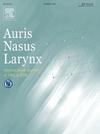Association of olfactory training with olfactory bulb morphology in adults with post-viral long-lasting olfactory dysfunction: A COVID-19 related prospective study
IF 1.6
4区 医学
Q2 OTORHINOLARYNGOLOGY
引用次数: 0
Abstract
Objective
In this prospective case-controlled study, we aimed to examine changes in olfactory bulb (OB) morphology due to COVID-19 infection and to examine the effects of olfactory training (OT).
Methods
This study included 29 patients with anosmia or hyposmia due to COVID-19 infection (Group 1), 24 normosmic patients after COVID-19 infection (Group 2), and 25 normosmic subjects without COVID-19 infection (Group 3). OB volumes, thickness, length, sulcus depth, and signal intensity were evaluated using magnetic resonance imaging (MRI). Psychophysical tests (odor discrimination, thresholds, and odor identification) and a survey of olfactory symptoms were performed. After 12 weeks of OT, the MRI data and odor scores of Group 1 were compared with those of the other groups.
Results
OB volumes were significantly smaller in Group 1 (54.01±2.92 mm3) compared with the other groups (group 2:56.7±3.2 mm3 and group 3:59.45±3.09 mm3). The OB thicknesses and lengths differed significantly between Group 1 and Groups 2 and 3. Group 1 had abnormalities in the OB signal intensity in the form of diffusely increased signal intensity compared with the others groups. Following OT, OB volume (right, p= 0.002; left, p=0.021) and Threshold Discrimination Identification score (p< 0.001) significantly increased in Group 1 patients.
Conclusion
These findings suggest that post-COVID olfactory loss is associated with smaller OB volumes and increased OB signal intensity. Additionally, this study provides evidence supporting the effectiveness of OT in improving olfactory function and OB volume in patients with long-lasting post-COVID-19 symptoms.
一项与COVID-19相关的前瞻性研究:成人病毒后长期嗅觉功能障碍患者嗅觉训练与嗅球形态的关系
目的在本前瞻性病例对照研究中,研究新冠肺炎感染后嗅球形态的变化及嗅觉训练的效果。方法选取29例新冠肺炎感染后嗅觉缺失或低通气患者(1组)、24例新冠肺炎感染后正常患者(2组)和25例未感染正常患者(3组)。采用磁共振成像(MRI)技术评价OB的体积、厚度、长度、沟深和信号强度。进行了心理物理测试(气味辨别、阈值和气味识别)和嗅觉症状调查。OT 12周后,比较1组与其他组的MRI数据和气味评分。结果1组的脑组织体积(54.01±2.92 mm3)明显小于2组(56.7±3.2 mm3和3:59.45±3.09 mm3)。第1组与第2、3组OB的厚度和长度差异有统计学意义。与其他组比较,1组OB信号强度异常,表现为弥漫性增强。OT后,OB体积(右,p= 0.002;左,p=0.021)和阈值判别识别评分(p<;0.001)显著增加。结论新冠肺炎后嗅觉丧失与OB体积减小和OB信号强度升高有关。此外,本研究提供证据支持OT在改善covid -19后长期症状患者的嗅觉功能和OB体积方面的有效性。
本文章由计算机程序翻译,如有差异,请以英文原文为准。
求助全文
约1分钟内获得全文
求助全文
来源期刊

Auris Nasus Larynx
医学-耳鼻喉科学
CiteScore
3.40
自引率
5.90%
发文量
169
审稿时长
30 days
期刊介绍:
The international journal Auris Nasus Larynx provides the opportunity for rapid, carefully reviewed publications concerning the fundamental and clinical aspects of otorhinolaryngology and related fields. This includes otology, neurotology, bronchoesophagology, laryngology, rhinology, allergology, head and neck medicine and oncologic surgery, maxillofacial and plastic surgery, audiology, speech science.
Original papers, short communications and original case reports can be submitted. Reviews on recent developments are invited regularly and Letters to the Editor commenting on papers or any aspect of Auris Nasus Larynx are welcomed.
Founded in 1973 and previously published by the Society for Promotion of International Otorhinolaryngology, the journal is now the official English-language journal of the Oto-Rhino-Laryngological Society of Japan, Inc. The aim of its new international Editorial Board is to make Auris Nasus Larynx an international forum for high quality research and clinical sciences.
 求助内容:
求助内容: 应助结果提醒方式:
应助结果提醒方式:


